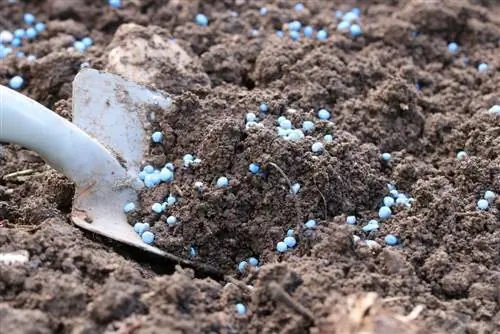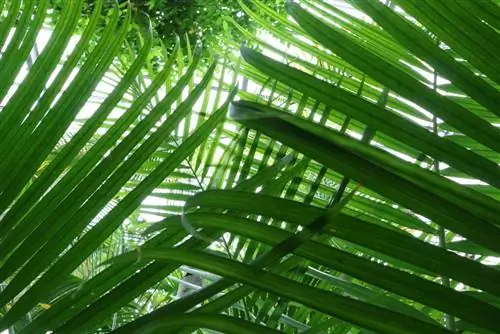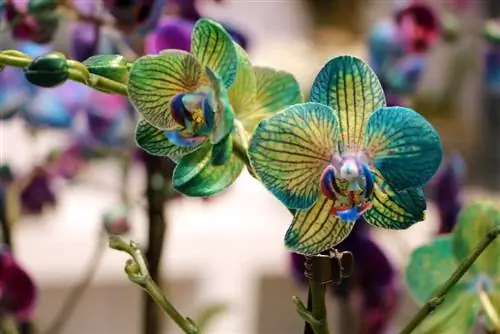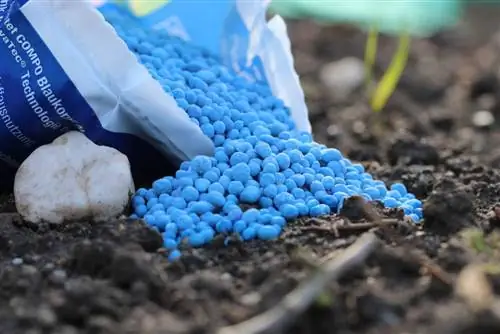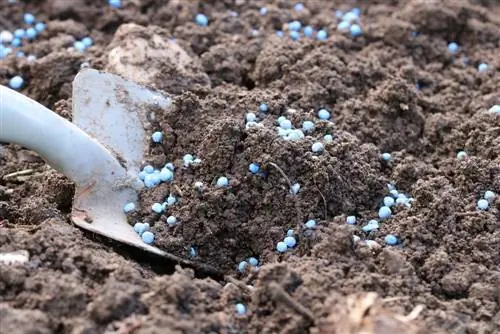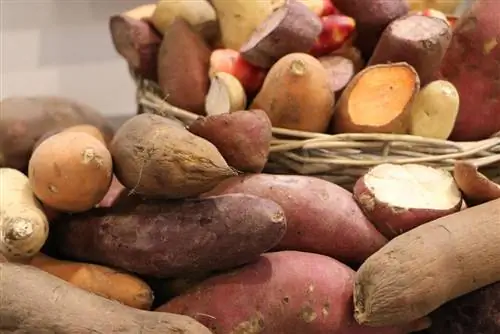- Author admin [email protected].
- Public 2023-12-17 03:39.
- Last modified 2025-06-01 06:48.
Blue grain is a popular fertilizer for the garden. Applied in the correct dosage, the blue grain is also practical and nutrient-rich, and also relatively inexpensive compared to other fertilizers.
Blue grain as fertilizer for plants
The blue grain should be used as a fertilizer with caution, because it has to be used carefully in terms of dosage and it is not equally suitable for every plant. In order to achieve splendid growth in front garden as well as garden and container plants and to achieve strong flower growth, blue grain is a very good fertilizer option. However, before using this fertilizer, you should first know the requirements of the individual plants and also determine the condition of the soil. This prevents you from ultimately having to compensate when using blue grain. By fertilizing with blue grain, the plants receive nutrients and minerals as well as trace elements that they need for their growth and the formation of flowers.
Blue grain as fertilizer is
- suitable for magnificent growth and abundance of flowers
- must be dosed carefully
- must be adapted to the soil conditions
- brings both minerals and trace elements for the plants
What is blue grain anyway?
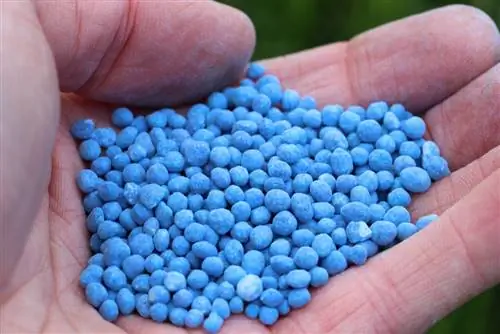
Blue grain is basically an industrial fertilizer that is more suitable for use in the garden than for domestic potted plants. The poor dosing of plants that only have a low nutrient requirement - such as potted plants - makes the fertilizer rather unsuitable for these plants. Blaukorn is a high-dose fertilizer that has a high concentration of nutrient s alts. This means that an overdose can cause the roots to burn, which ultimately causes the plants to die if they are over-fertilized. Blue grain is not suitable as a fertilizer for domestic potted plants; the classic liquid fertilizer, which is added together with the irrigation water, should be preferred. Blaukorn is particularly suitable in the garden for evergreen plants such as rhododendrons, as they require a high concentration of nutrient s alts. In the open field, Blaukorn is also suitable for a limited period of time for plants that have a high level of bud formation and therefore require a lot of nutrient s alts for the buds and flowers to sprout.
Blue grain as fertilizer
- is not suitable for houseplants with relatively low fertilizer requirements
- can be a good solution, especially for evergreen plants like rhododendrons
- is suitable outdoors for plants with abundant bud and flower shoots
Dosage and application
If you decide to use blue grain as a fertilizer, you should proceed carefully with potted and green plants in order to avoid over-fertilization and thus damage to the plant. A few grains of fertilizer are enough to fertilize. To do this, a few balls of blue grain are placed on the moist soil at some distance from the plant trunk and thus the roots. The plant is then watered abundantly so that the blue grain can dissolve and does not remain in concentrated form in the soil. If potted plants are fertilized with blue grain, you should avoid water congestion, because the nutrient s alts also collect in compressed form here and can have a lasting effect on the roots. If balcony boxes are to be fertilized with blue grain, the fertilizer is distributed in small pinches on the soil. If there is no drainage in the box, then only very few beads of fertilizer should be used because otherwise the nutrients and s alts will concentrate in the bottom area of the flower box.
Blue grain should be used especially in the growth and vegetation phase in spring, because this is the time when the plants can best convert and utilize the minerals for rapid growth. To ensure that there is no concentration of nutrient s alt in the box, fertilization with blue grain should be carried out at most once a month for potted plants without drainage. It is always important to water the plants treated with blue grain - outdoors as well as in pots or balcony boxes - well when it is warm so that the s alts in the soil dissolve and can be transported into the plant via the roots and do not remain concentrated in the soil.
Blue grain is best used
- applied in small doses to the moist soil
- dissolved with a lot of water so that it can penetrate into the soil
- only for adult plants and not for young plants
Use of blue grain in irrigation water
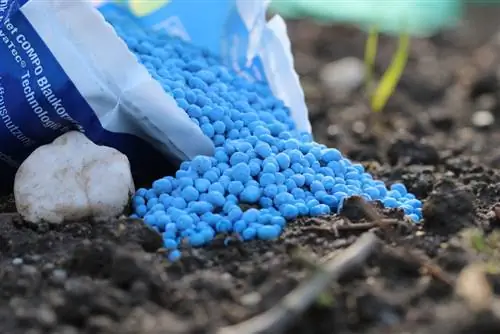
If you want to use Blaukorn directly with the irrigation water, then a dosage of five grams per ten liters of water is ideal during the plants' growth phase. Even when fertilizing with irrigation water, it is sufficient to use blue grain once a month, otherwise a plant-damaging effect can occur. Young plants should never be fertilized with blue grain, both in the garden and in the container, because the roots are still very sensitive.
Blue grain in irrigation water
- is dosed with five grams of fertilizer per ten liters of water
- applied once a month
- is ideal for the growth phase of potted plants.
Advantages and disadvantages of blue grain
Blaukorn is a mineral fertilizer that provides nutrients in water-soluble form. The most important nutrients contained are nitrogen and phosphate as well as potassium. The plants can absorb and utilize the nutrients immediately in the dissolved form. The rapid availability of nutrients is a key advantage of blue grain. It is also inexpensive and available from just two euros per kilogram. Another advantage is that Blaukorn is a complete fertilizer.
Blue grain can quickly lead to over-fertilization, which has a damaging effect on the roots. Good dosage is more important here than with other fertilizers. Caution should be exercised when fertilizing fruits and vegetables with blue grain, as the fruits can quickly become contaminated with too much nitrite.
Blaukorn - advantages
- mineral, water-soluble fertilizer
- brings quick supply to the plants
- cheap
Blue grain - disadvantages
- Overfertilization is a risk
- can cause nitrate contamination, especially in fruits and vegetables at high doses
What you should know about Blaukorn in brief
Blaukorn is a purely mineral artificial fertilizer and contains no organic material whatsoever, which inevitably means that the soil fertilized with Blaukorn is not a starting material for humus formation! Blue grain can basically be used for all cultivated plants, such as vegetables and fruit, but also for lawns or ornamental plants.

There are various manufacturers of blue grain on the market, although there are differences in the composition of the ingredients it contains, such as potash, nitrogen and phosphorus, as well as other trace elements. There are varieties of Blaukorn that are lower in nitrogen, but there are also varieties of Blaukorn that are rich in nitrogen. Blue grain is also available as granules in various pack sizes and also as a liquid fertilizer.
- Liquid fertilizer is applied to the soil using a watering can.
- You should preferably fertilize plants such as tomatoes or pumpkin etc. with blue grain.
- Plants that are adapted to poor soil should not be fertilized with blue grain, including many types of grass, poppies and moor plants.
- Blue grain also causes plants to sometimes only grow in length without them bearing flowers or fruit.
- When nasturtiums are heavily fertilized with blue grain, only a few shoots and leaves and only a few flowers form.
It is important that you read the information on the packaging very carefully when purchasing, because different compositions are recommended for different crops. The blue grain beads only gradually dissolve after application. They continually release nutrients. If you intend to fertilize your lawn, you should make sure that it is dry and can then be watered sufficiently.

